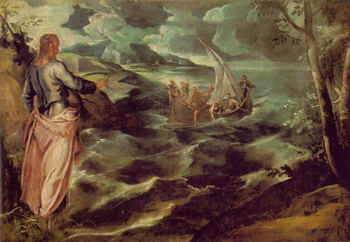| Search Art Prints | ||||||||||||||||||||
| Search Artists | ||||||||||||||||||||

|
||||||||||||||||||||
|
|
|||||||||||||||||||

Christ at the Sea of Galilee

|
Christ at the Sea of Galilee
The painting is from the High Renaissance period and is an example of mannerism, which is the observation of figure, light, perspective and the artists’ emotional outlook of the scene. With Tintoretto’s famous painting of Christ at the Sea of Galilee; which hangs in the National Gallery of Art in Washington DC, Christ is in the foreground arms outstretched while raging waves terrorize the apostles in the sea. Again Tintoretto’s dramatic use of color and light is seen here with brooding clouds. Tintoretto also organized his postures for maximum emotion. In the painting the disciples seem to be panicked and in extreme disarray. The painting was at one time sold by the Philippine government to pay for aid to victims of an earthquake. Tintoretto till this day has the honour of having the largest oil painting, and being considered one of the great artists of the Renaissance.
High Renaissance Painter Jacopo Tintoretto – Color and Style
Tintoretto is the name given to Venetian painter Jacopo Cumin. Born in Italy (1518- 1594) he is considered one of the last great painters of the Renaissance Period. His talent was discovered at an early age and his father took him to Titian the cities most famous painter to develop his skill.
Tintoretto Develops His Style
Tintoretto’s figures show dynamics with expression, posture and color. Although he preferred muted color, Tintoretto’s work exhibits a true intensity. Tintoretto was able to achieve such rich texture by not only layering his colors but also by mixing in glass to his paints. Under high magnification with an electron microscope, Tintoretto’s work has shown green glass. The glass is seen to contain areas of blue from cobalt and areas of yellow from iron. The mix of colors summed into a green hue. Through x ray examination, they’ve discovered that Tintoretto would sketch a nude drawing for the rough positioning of his figures. Once the framework was done he then painted his full character details. Tintoretto would work out the lighting on his figures by sculpting the figure and lighting them by candle. He works a lot with shafts of light to accent divinity and mood in his paintings. His main characters are posed expressively and coloured richly as his background figures and locations are painted muted colors. The style draws the attention of the eye and is a technique that Tintoretto used until the end of his career.











